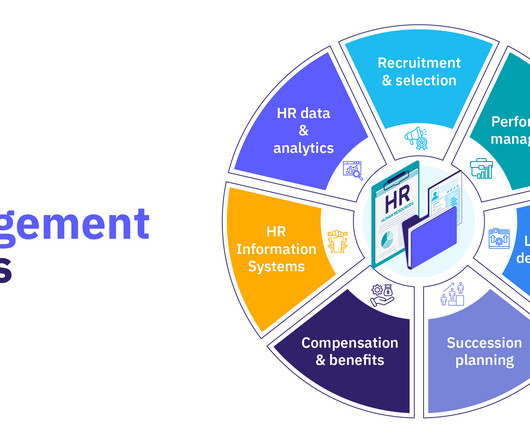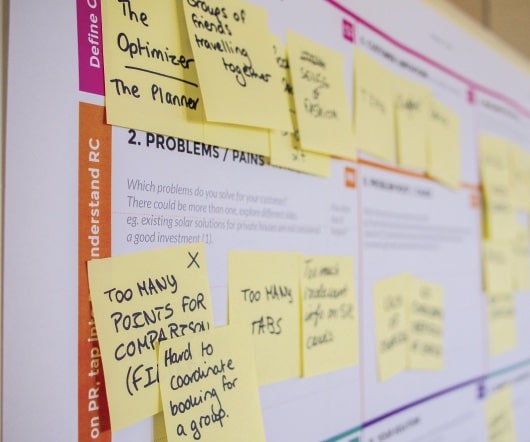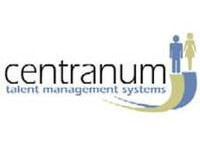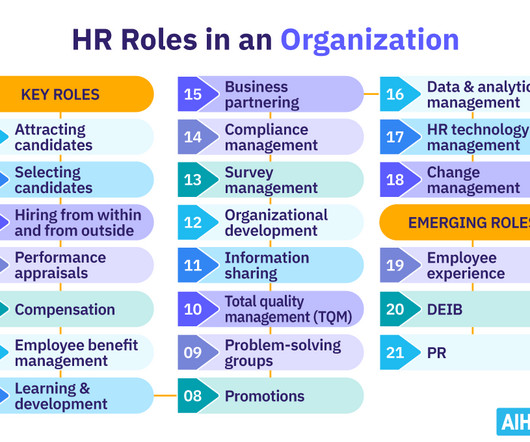Best enterprise HR software systems
HiBob
SEPTEMBER 18, 2024
BambooHR supports growing teams in over 150 countries.
This site uses cookies to improve your experience. To help us insure we adhere to various privacy regulations, please select your country/region of residence. If you do not select a country, we will assume you are from the United States. Select your Cookie Settings or view our Privacy Policy and Terms of Use.
Cookies and similar technologies are used on this website for proper function of the website, for tracking performance analytics and for marketing purposes. We and some of our third-party providers may use cookie data for various purposes. Please review the cookie settings below and choose your preference.
Used for the proper function of the website
Used for monitoring website traffic and interactions
Cookies and similar technologies are used on this website for proper function of the website, for tracking performance analytics and for marketing purposes. We and some of our third-party providers may use cookie data for various purposes. Please review the cookie settings below and choose your preference.

HiBob
SEPTEMBER 18, 2024
BambooHR supports growing teams in over 150 countries.

AIHR
JUNE 3, 2025
A succession planning toolkit gives HR leaders the structure, clarity, and confidence to navigate leadership transitions without disrupting business momentum. A Harvard Business Review study revealing that poorly managed CEO and C-suite transitions cost S&P 1500 companies nearly US$1 trillion in lost market value annually.
This site is protected by reCAPTCHA and the Google Privacy Policy and Terms of Service apply.
Can Your Organization Spot a Conflict Before It’s a Crisis?
How to Turn “Check-the-Box” Compliance Trainings Into Real Learning
Is Your Background Screening Policy Built For 2025? What HR Leaders Need To Know Now
Predict Retention with Confidence: What to Look for Before You Hire

HRExecutive
SEPTEMBER 18, 2024
For example, when an organization hires a new employee, HR can enter the employee’s information into one SOR, and an API automatically sends that data to other systems, such as time tracking or learning management. APIs are not software applications or productized solutions. APIs are like building blocks.

HR Lineup
SEPTEMBER 24, 2024
Succession Planning Succession planning ensures that organizations have a pipeline of qualified candidates to fill key roles in the future. Key elements of succession planning include: Identifying Talent: Recognizing employees with the potential to take on leadership roles.

Terryberry
APRIL 29, 2024
This type of system includes all the features offered by HRIS and adds talent management capabilities to the mix. Additional functionality includes advanced talent management tasks such as performance management, learning, succession planning, and compensation planning.

AIHR
APRIL 17, 2025
HR professionals use a talent management framework to guide them through and optimize the entire talent life cycle , from recruitment efforts and performance management to succession planning. Why does your organization need a talent management framework?

HR Lineup
MARCH 24, 2025
healthcare compliance, cybersecurity) Use machine learning algorithms to continuously refine and update this taxonomy. Step 2: Build a Skills Taxonomy Develop a comprehensive skills database that categorizes skills into: Core skills (e.g., problem-solving, communication) Technical skills (e.g.,

HR Management
JULY 29, 2024
a) Talent Recruitment and Management: Cloud-based Applicant Tracking Systems (ATS) streamline the recruitment process by automating tasks such as sourcing candidates, screening resumes, scheduling interviews and facilitating collaboration among hiring teams.

InfinityHR
JUNE 21, 2019
From Drew Bledsoe to Tom Brady; David Robinson to Tim Duncan; transferring power from one leader to another can be a seamless and successful process, not just in the sports world, but within the corporate one too. Key Areas of Evaluation in Succession Planning. Maximize Efficiency with Succession Planning Software.

AIHR
MARCH 2, 2020
Recruiting data gathered from the Applicant Tracking System (ATS) is the first common data source in the HRIS. The performance management system (PMS) is part of the HRIS and contains information about performance management. For more information, check our full guide on performance management.

Hppy
NOVEMBER 3, 2023
Popular HR Management Software Some of the popular HR management software tools include Zenefits, BambooHR, and UltiPro. Benefits of Applicant Tracking Systems ATS can assist in streamlining the recruitment process, minimizing administrative errors from manual recruitment methods.

i4cp
FEBRUARY 2, 2022
Succession planning / management has long been a high priority at many organizations. This approach might soon become a more common best practice, as several participants on the call indicated this was a change their organizations made recently or are planning to make in 2022.

cipHR
NOVEMBER 17, 2020
Applicant Tracking System (ATS) – an application, such as CIPHR iRecruit , that enables the electronic handling of recruitment needs. Application Programming Interface (API) – is a set of code that enables two separate applications, or more, to interact.

HR Lineup
AUGUST 6, 2024
Performance Management: Continuous performance tracking and feedback mechanisms. Learning and Development: Integrated learning management system (LMS) for employee growth. Compensation Management: Robust tools for managing employee compensation and rewards.

HR Lineup
APRIL 11, 2024
It encompasses a broad spectrum of tools and platforms designed to optimize recruitment, talent management, employee engagement, performance evaluation, and other HR-related activities. These systems provide a unified database accessible to HR professionals, managers, and employees, enabling efficient data management and analysis.

Digital HR Tech
JULY 1, 2019
What is Human Resource Management. Performance management. Learning & development. Succession planning. HR Information Systems. What is Human Resource Management? Human Resource Management, or HRM, is the practice of managing people to achieve better performance. Succession planning.

HR Stacks Blog
JUNE 15, 2025
Recruitment & Onboarding Tools An HRIS equipped with an integrated Applicant Tracking System (ATS) and automated onboarding workflows streamlines talent acquisition from posting jobs through the first weeks on the job. Supports compliance and audits : Maintains audit-ready records and adapts to changing labor laws.

HiBob
JULY 30, 2024
Roles and responsibilities Brief executives on key HR team initiatives Ensure the HR team takes an efficient approach to common challenges Structure benefits and compensation programs to attract the best talent Manage high-level HR functions, including talent acquisition, leadership development, and succession planning Work with the executive team (..)

HiBob
OCTOBER 3, 2024
HR process automation HR growth tools automate repetitive HR tasks like job postings , payroll processing, and tracking absences. This frees up valuable time for HR professionals to focus on advanced HR strategies like succession planning , leadership development, company culture initiatives, and recruitment efforts.

AIHR
APRIL 15, 2024
Contents What is Human Resource Management? Performance management 3. Learning & development 4. Succession planning 5. HR Information Systems 7. HR data and analytics How has Human Resource Management changed and evolved? Human Resource Management skills FAQ What is Human Resource Management?

HiBob
OCTOBER 17, 2024
Key features: Performance management capabilities HR data analytics and reporting Applicant tracking system Employee database and reporting ( The article includes platform features that reflect the information available as of the publication date.)

InfinityHR
MAY 24, 2019
The automated tools available include: Applicant Tracking System. Performance Management. Learning Management. Succession Planning. Evaluate your missing skills with Performance Management and Succession Planning. How to Create a Successful Succession Planning Process.

BirdDogHR
MARCH 8, 2017
These are just a few reasons why it’s crucial to provide applicants with a short, user-friendly mobile interface to prevent potentially-qualified applicants from applying for a job elsewhere. Take advantage of our additional talent management solutions and contact us with any questions. Learning Management. (4).

HR Lineup
MAY 6, 2023
This software provides organizations with a comprehensive solution for recruiting, performance management, learning and development, and succession planning. One of the key features of Centranum is its applicant tracking system (ATS), which allows companies to manage their recruitment process more effectively.

Accendo Technologies
APRIL 12, 2023
Application forms, which are collected through online application systems, applicant tracking systems, or manually through paper forms. Assessments, which are conducted through pre-employment testing software, which may be integrated with applicant tracking systems.

BirdDogHR
JUNE 13, 2017
To see the BirdDogHR Applicant Tracking System (ATS) and Onboarding modules in action, schedule a demo. Learning Management. (5). Risk Management. (2). Succession Planning. (3). Talent Management. (4). For more information, contact us. Sign Up for Email Updates. Recent Posts. Mobility.

InfinityHR
MAY 17, 2019
A Talent Management strategy is a construction of ideas, methodology and processes that help interconnect employee interests to align with greater business objectives and goals. It’s also used to support: Learning and succession planning for employees. Continuing education for employees to learn and grow new skills.

HR Lineup
JULY 3, 2024
Key tools include: Applicant Tracking Systems (ATS): Use ATS to streamline the hiring process and identify top candidates. Learning Management Systems (LMS): Implement LMS to support continuous learning and development. Succession Planning: Identify and develop future leaders within the organization.

InfinityHR
APRIL 26, 2019
To create this type of harmony within your talent management strategy, it’s important to consider the benefits of automating HR processes with cloud-based modules, systems or platforms to support your goals and initiatives for the future. Performance Management. Learning Management. Succession Planning.

BirdDogHR
MAY 9, 2017
By giving frequent feedback in addition to annual reviews, your Millennial workforce will be set on the right track and headed toward success. With a little help from your organization’s succession plan, Millennials are interested in staying in one career. Learning Management. (5). Succession Planning. (3).

BirdDogHR
APRIL 4, 2017
Ensure that your company’s first impression is a great one by taking advantage of a mobile-friendly and easy-to-use Applicant Tracking System (ATS). To see our ATS and Onboarding software in action, schedule a demo , or read more about BirdDogHR’s talent management solutions. Learning Management. (5).

HR Lineup
JULY 28, 2023
The platform provides an intuitive applicant tracking system (ATS) that allows recruiters to manage the entire recruitment lifecycle seamlessly. Managers can provide regular feedback, conduct performance appraisals, and identify areas for improvement, fostering a culture of continuous learning and growth.

BirdDogHR
MAY 30, 2017
Our system is updated as new OFCCP, VEVRAA, and Section 503 of the Rehabilitation Act regulations are put into place. Learn more about the BirdDogHR Applicant Tracking System (ATS) or download the Record Keeping for the Hiring Process and How It Affects Affirmative Action Compliance whitepaper. Construction. (13).

Peoplebox
OCTOBER 28, 2024
Integrating talent management systems into one platform gives you a competitive advantage – comprehensive data analytics that empowers HR leaders to make informed, proactive decisions. By analyzing workforce data, you can accurately predict future talent needs, identify skill gaps, and build succession plans.

Terryberry
SEPTEMBER 22, 2022
This type of system includes all the features offered by HRIS and adds talent management capabilities to the mix. These include compensation planning, learning and development, succession planning and career planning. Applicant Tracking System. Workforce Management.

HR Lineup
JUNE 6, 2024
BambooHR BambooHR is a comprehensive HR software designed to streamline every aspect of human resources, from hiring and onboarding to performance management and employee data management. Key Features: Applicant Tracking System (ATS): Simplifies the recruitment process by tracking job applicants and managing resumes.

cipHR
JULY 12, 2023
Spanning technical and technological, HR and L&D, learning, and professional learning bodies, here’s our essential L&D A to Z A | B | C | D | E | F | G | H | I | J | K | L | M | N | O | P | Q | R | S | T | U | V | W | X | A ATS – Applicant Tracking System.

Empuls
JUNE 8, 2023
Key features Applicant tracking system Time-off tracking Performance management HR reporting Employee self-service Pros It is easy to use and navigate. It is designed to help companies manage the entire employee lifecycle. You will get a free trial before buying. Excellent customer service.

InfinityHR
JULY 19, 2019
Aside from a powerful, cloud-based Benefits Management module, InfinityHR features the following modules within the full platform: Core HR. Applicant Tracking System. Performance Management. Learning Management. Succession Planning. ACA Compliance. Time and Attendance. Onboarding.

Terryberry
MAY 14, 2024
Talent management software can aid in everything from attracting and onboarding new recruits, to developing and retaining existing talent, to boosting employee engagement. Improved Performance Management: TMS can set goals, track progress, and provide feedback mechanisms to boost employee performance.

Heyyy HR!
SEPTEMBER 24, 2024
This will require managers to allow employees a level of autonomy. Career Pathing and Succession Planning Career pathing involves planning future roles for employees within your company that can benefit the employee and the company. Succession planning is key for ensuring leadership continuity.

InfinityHR
MAY 20, 2019
Employers can improve processes and take advantage of a multitude of HR automated solutions available to them in order to revamp their recruiting, onboarding, performance management, learning management and succession planning initiatives. Performance management. Learning management.

AIHR
JANUARY 5, 2024
With a combination of employee training and smart succession planning , HR helps to create a strong talent pipeline in the company where jobs can be filled with internal talent. Also known as digital HR, technology management is enabling efficient HR practices and a better employee journey.

InfinityHR
JULY 3, 2019
Aside from a robust, cloud-based Benefits Management module, InfinityHR features the following modules within the full platform: Core HR. Applicant Tracking System. Performance Management. Learning Management. Succession Planning. ACA Compiance. Time and Attendance. Payroll Processing.
Expert insights. Personalized for you.
Are you sure you want to cancel your subscriptions?


Let's personalize your content